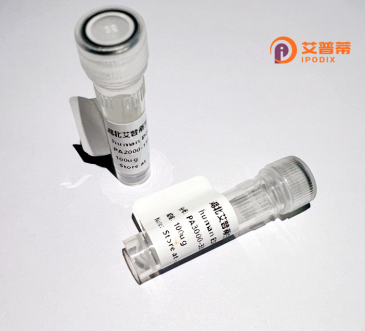
| 纯度 | >90%SDS-PAGE. |
| 种属 | Human |
| 靶点 | TXNDC |
| Uniprot No | Q9H3N1 |
| 内毒素 | < 0.01EU/μg |
| 表达宿主 | E.coli |
| 表达区间 | 1-280 aa |
| 活性数据 | MAPSGSLAVPLAVMVPLLWGAPWTHGRRSNVRVITDENWRELLEGDWMIEFYAPWCPACQNLQPEWESFAEWGEDLEVNIAKVDVTEQPGLSGRFIINALPTIYHCKDGEFRRYQGPRTKKDFINFISDKEWKSIEPVSSWFGPGSVLMSSMSALFQLSMWIRTCHNYFIEDLGLPVWGSYTVFALATLFSGLLLGLCMIFVADCLCPSKRRRPQPYPYPSKKLLSESAQPLKKVEEEQEADEEDVSEEEAESKEGTNKDFPQNAIRQRSLGPSLATDKS |
| 分子量 | 58.2 kDa |
| 蛋白标签 | GST-tag at N-terminal |
| 缓冲液 | PBS, pH7.4, containing 0.01% SKL, 1mM DTT, 5% Trehalose and Proclin300. |
| 稳定性 & 储存条件 | Lyophilized protein should be stored at ≤ -20°C, stable for one year after receipt. Reconstituted protein solution can be stored at 2-8°C for 2-7 days. Aliquots of reconstituted samples are stable at ≤ -20°C for 3 months. |
| 复溶 | Always centrifuge tubes before opening.Do not mix by vortex or pipetting. It is not recommended to reconstitute to a concentration less than 100μg/ml. Dissolve the lyophilized protein in distilled water. Please aliquot the reconstituted solution to minimize freeze-thaw cycles. |
以下是3条关于重组人TXNDC蛋白的参考文献摘要简述:
1. **"Recombinant TXNDC5 Promotes Cancer Cell Proliferation via AKT Signaling"**
- **作者**: Zhang Y, et al.
- **摘要**: 研究证实重组人TXNDC5蛋白通过激活AKT/mTOR信号通路增强肝癌细胞增殖和转移,提示其在肿瘤治疗中的潜在靶点作用。
2. **"Oxidative Stress Modulation by Recombinant Human TXNDC16 in Vascular Endothelial Cells"**
- **作者**: Li H, et al.
- **摘要**: 实验发现重组人TXNDC16蛋白通过调控硫氧还蛋白系统减轻内皮细胞氧化损伤,可能对心血管疾病具有保护效应。
3. **"Structural Characterization of Recombinant TXNDC3 and Its Role in Protein Folding"**
- **作者**: Wang X, et al.
- **摘要**: 通过X射线晶体学解析重组人TXNDC3蛋白结构,揭示其通过二硫键异构酶活性协助错误折叠蛋白修复的分子机制。
建议通过PubMed或Web of Science以关键词“recombinant TXNDC”或“TXNDC5/TXNDC16”查阅更多相关文献,注意筛选近五年研究以获取最新进展。
Recombinant human TXNDC (thioredoxin domain-containing) proteins belong to a family of redox-regulating proteins involved in disulfide bond formation, isomerization, and cellular stress responses. These proteins share a conserved thioredoxin-like domain, enabling them to act as oxidoreductases that modulate redox homeostasis. TXNDC members, such as TXNDC5 (ERp46) and TXNDC17. are primarily localized in the endoplasmic reticulum (ER), where they assist in protein folding, quality control, and ER-associated degradation. Their dysregulation is linked to diseases like cancer, neurodegenerative disorders, and inflammatory conditions, often due to oxidative stress or disrupted protein maturation.
Recombinant TXNDC proteins are engineered using expression systems (e.g., E. coli, mammalian cells) to study their biochemical roles or therapeutic potential. They retain functional redox activity and are used in vitro to investigate interactions with client proteins, redox signaling pathways, and apoptotic mechanisms. Notably, TXNDC5 is implicated in tumor progression and angiogenesis, making recombinant forms valuable for drug screening. Additionally, these proteins hold promise in biotechnology for optimizing yields of disulfide-rich therapeutic proteins. Research continues to explore their roles in modulating immune responses and mitigating ER stress-related pathologies, positioning TXNDC proteins as both biomarkers and therapeutic targets. (Word count: 199)
×